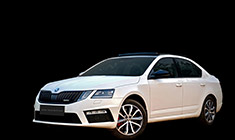News
1300 km coastal trip in a Nexon EV: Total time taken & charging costs
EV long trips require planning in advance and a risk appetite of being okay with getting stuck for a while.
BHPian govind_kaniyath recently shared this with other enthusiasts.
Coastal Road trip to Goa: EV long trips 101
Introduction
As a long weekend approached it was finally time for a coastal road trip from Kerala to Goa. Now comes choosing the car for it, Innova Crysta/Carens diesel AT came to my mind as an obvious choice. But I wanted this trip to be different, a whole new experience altogether.
Thus I chose the Nexon EV, which was used mostly as a city car.
This choice raised a few eyebrows among family members.
A quick search showed there were charging stations along the route and the trip could be done. Besides, as it was 2 bachelors going on a leisure trip, we didn't mind if we faced a few hours of downtime or if something went wrong.
Electric car road trip to celebrate Independence Day, Fantastic!
Thus the planning begins.
Planning, Risk appetite
Let me point first so that you can decide if EV long trips are for you or not:
EV long trips require planning in advance and a risk appetite of being okay with getting stuck for a while.
If either of those is a problem, then you have to steer clear of EV long trips.
Now comes the planning part
The sad reality of the Indian EV charging space is there are multiple apps that host charging stations. Tatapower, Bolt Earth, Chargezone, Statiq etc. On my phone, I have around 30 different EV charging apps. It's a huge pain to look for chargers on all the apps and keep the wallet recharged on most of them. Only the government can sort this out.
As of now, the best option is called "plugshare".
It's an open-source website/ app on which EV users themselves add charging stations on a map with other details like power, connectors available, etc. A benefit of this app is that users can add their dated reviews in the form of comments. So we understand if the charger is working or not.
Of course, this only provides a rough idea of location, to charge from there we'll have to check the app on which charger is hosted. Another benefit is its trip planner feature. It works best on a laptop and enables us to set a route to a location based on our vehicle's range and charging stops.
I'll add a few links on how to understand plugshare trip planner works from youtube.
As I started from Kozhikode, I chose the following charging stations along the route:
- ANERT charging station, Agricultural University, Kasargod
- Relux Charging station, Manipal Inn, Udupi
- Jio BP charging Station, Sagar residency, Honnavar
Slow charging at the hotel, same route back.
While choosing these charging stations, I kept a few things in mind:
- Backup chargers nearby planned charging stops.
- Reserve charge to reach backup chargers.
- Should have restaurants nearby
For Nexon EV Prime, I suggest to space out charging stops between 150 to 160km.
The EV drive:
Since I was traveling from Kozhikode, my 1st objective was to leave Kerala before the traffic settles in.
Kerala highways and traffic is downright horrible, there's no two ways about it. If we get stuck in traffic, the headache would be a huge mood spoiler.
So I started the trip at 4:30 Sunday morning.
Tip:
Before starting a long trip, make sure your EV is full charged or almost charged before you go to bed. The reason is, I've had a few occasions in which the car wouldn't have charged overnight due to some reason. So it's better to be safe
I've packed the EV essentials like an extension cable, a chain and lock to secure my charger, an extra earthing rod (if the slow charging point doesn't have proper earthing)
On Kerala roads, due to slight traffic and low speeds, I was using regen a lot and got really good efficiency.
After picking up my friend, we stopped at the ANERT charging station in Kasargod.
The app had a server issue and it took around 10mins to get back working again.
I plugged the car at 33 percent and charged to 80.
After having breakfast at the attached restaurant we stopped the charging session at 80%. Didn't spend any extra time for charging.
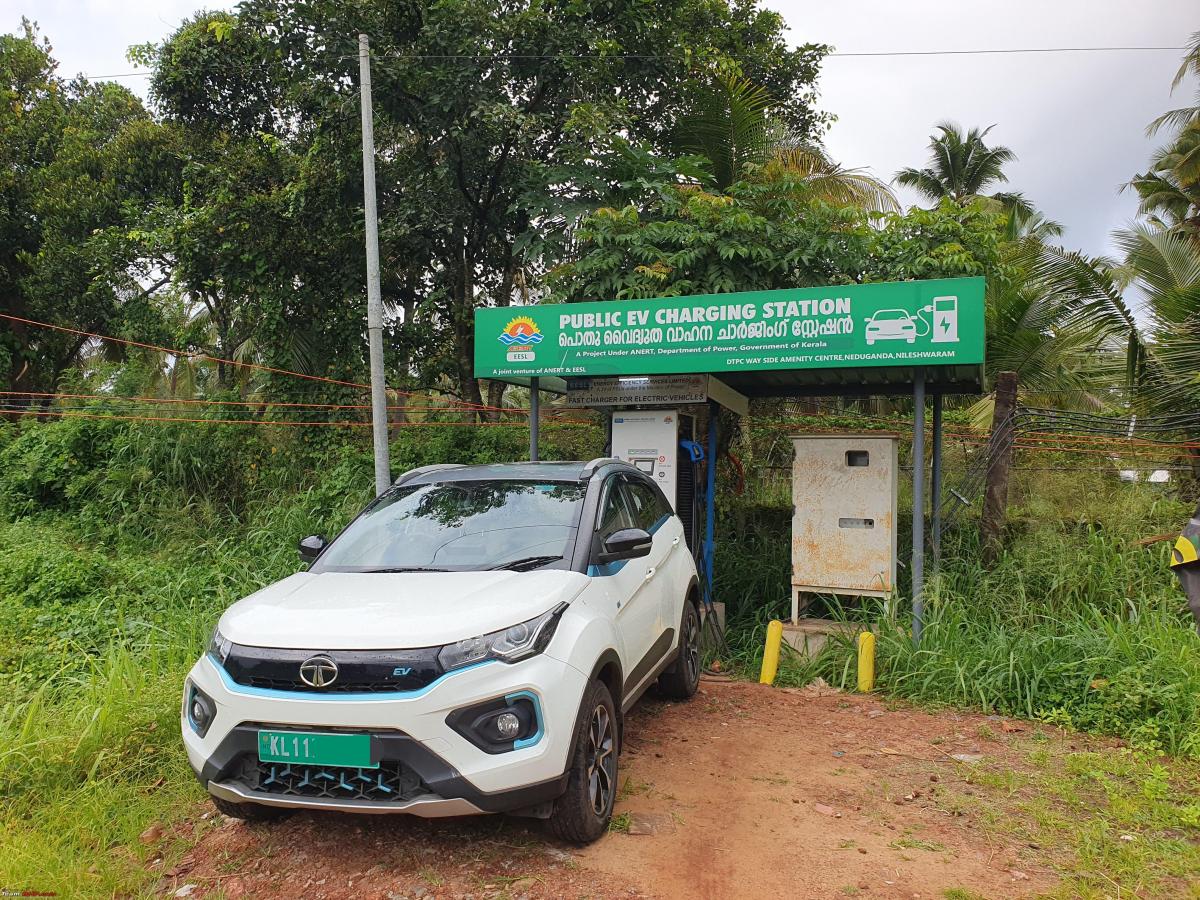
Soon we entered Karnataka and the roads opened up. Nexon's cruise was set at the legal speed limit of 80kph.
At Udupi, I took the next charging stop.
Location: Manipal Inn.
Relux charger. This charger had 2 ccs guns.
An MG and a Tigor was charging from there, they stopped charging at around 75% charge and soon I plugged in. That's called fast-charging etiquette. More about that later.
Similar to our breakfast stop, we utilized the charging time for a sumptuous lunch. Do try the Hyderabadi biriyani there, it's superb.
The charger automatically stopped charging at 85%.

We continued with the journey.
It's from this stretch the really scenic roads start.
Coconut trees on the highway side, lush greenery throughout, and many scenic river crossings. Driving the Nexon EV through these roads knowing EVs help to preserve mother nature was a good feeling.
Then came Maravanthe Beach. Oh god! how epic were the views. Ocean on one side and river on the other side of the road. It was nothing short of soul-cleansing. We stopped by to snap a few photos.

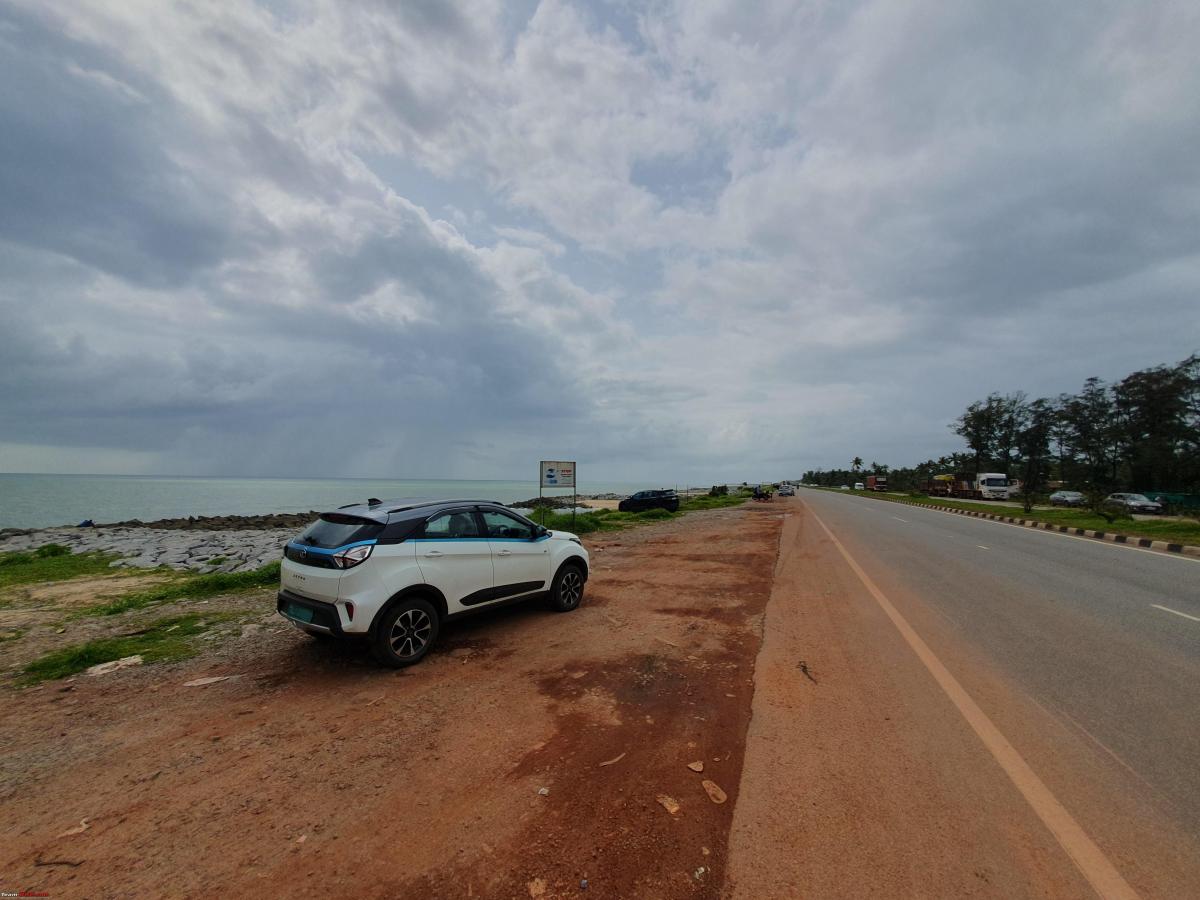
The road trip was already feeling really good. We took the final charging stop at the Jio BP charger in Honnavar. While the car charged we had a filter coffee and hot pav bhajis from the attached restaurant Sagar Residency. While we finished eating and approached the charger, a few locals gathered around our car.
The KL-registered Nexon EV in northern Karnataka sparked their interest.
Got the usual questions like cost for full cost, time to charge, on-road price etc. After a quick interaction, we unplugged and headed to Goa.

Had dinner at a Goan restaurant and went to the Air BnB we rented out.
They had a 16A wall socket there. Did a quick inspection of the wiring and made sure their MCB and RCCB (electrical safety devices) were up to mark. I used my personal Bolt lite charging point to measure electricity consumption. The car charged till full overnight and we had a well-deserved sleep.

Goa:
Since Goa was a pretty small place, we took the Nexon EV everywhere. Almost every place we went to people started asking about the EV and where we charged. There was one group of Mallu college students who were amazed and asked us if we got it here on a train!

We consumed around 40%charge during commutes inside Goa. After visiting a few places, it was time to head back. We decided to take turns driving and travel overnight.
Charged at St Regis Resort in Southern Goa, they had a charge zone charger. We took a coffee break to caffeine up for the long drive back home. Took the same route, and the same chargers, and timed it with our food breaks.
After leaving Kannur district in Kerala, the traffic went for the worst and it took almost 4 hours to travel 90 km to Kozhikode.
Really tired by driving through Kerala roads, plugged the car in had a shower, had dinner and called it a day.
Checked the trip meter the next day. 1363kms. In a Nexon EV prime. The trip meter gave me a proud feeling.
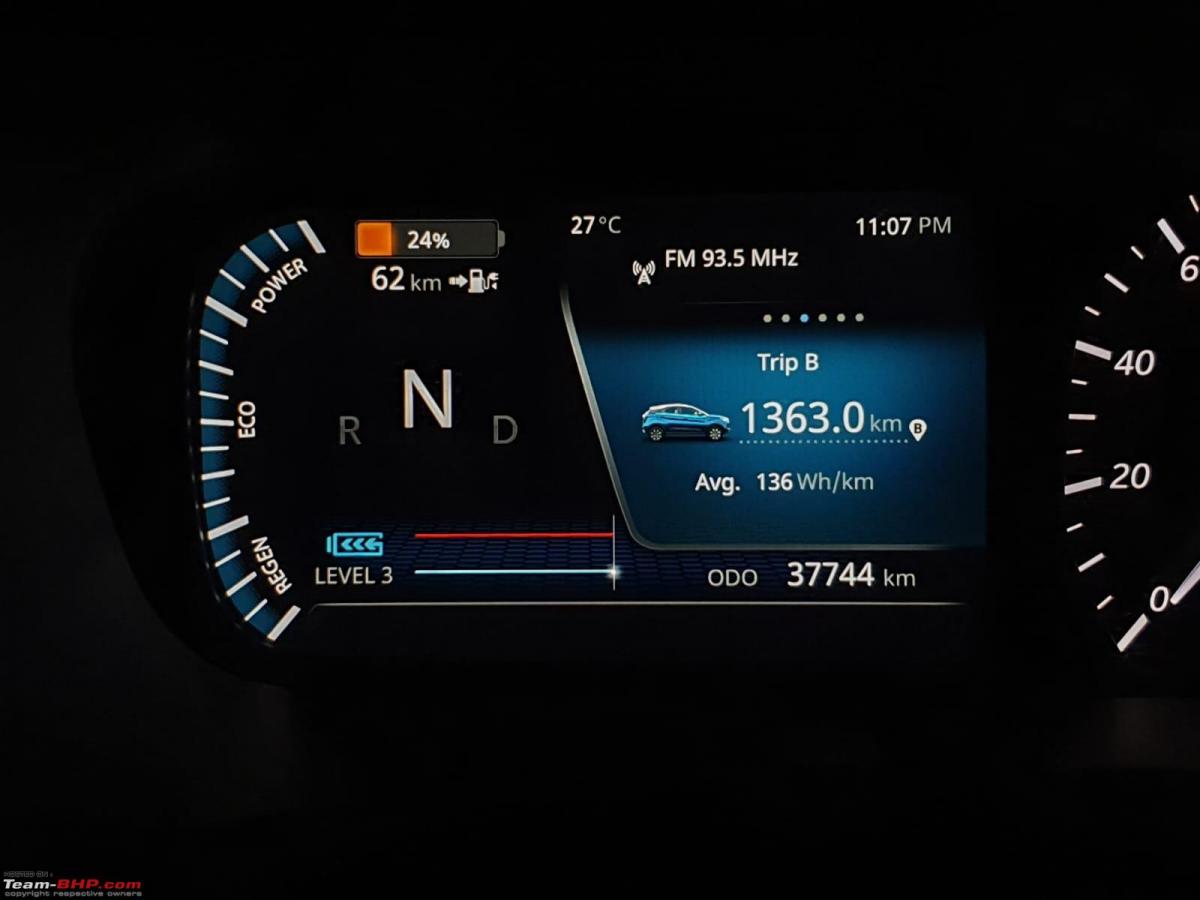
Now comes the important question: how much it cost to charge
The cost for fast charging depends on the fast charging network:
- In Kerala the chargers I used had a tariff of around 15rs/unit and in Karnataka it was around 24rs/ unit. Slow charging at the hotel only costed 7rs/unit.
- It's so cheap because slow charging doesn't need heavy complicated DC fast chargers.
- Hence slow charging is the most affordable form of EV charging.
- In every EV trip, you have to charge utilizing the time you have to spend at a place.
- Why spend a few hours at a fast charging station when the car can get charged overnight at the property you're staying at without wasting any vacation time?
The total charging cost was Rs. 3,385.
Total energy consumption for this trip was 182 units.
The average efficiency was 7.36km/unit or 133Wh/km
That's dirt cheap.
2.48rs/km.
I think most people would have an idea on how affordable it actually is, if I convert these numbers to ICE equivalents.
At the time of writing this review, price of petrol in Kerala is 108.33rs.
So the petrol equivalent fuel efficiency for Nexon EV in this trip would be (petrol cost per litre÷running cost per km)
43.63km/litre.
This ends the debate on Hybrids/EVs which are cheaper to run.
Attaching a graph below
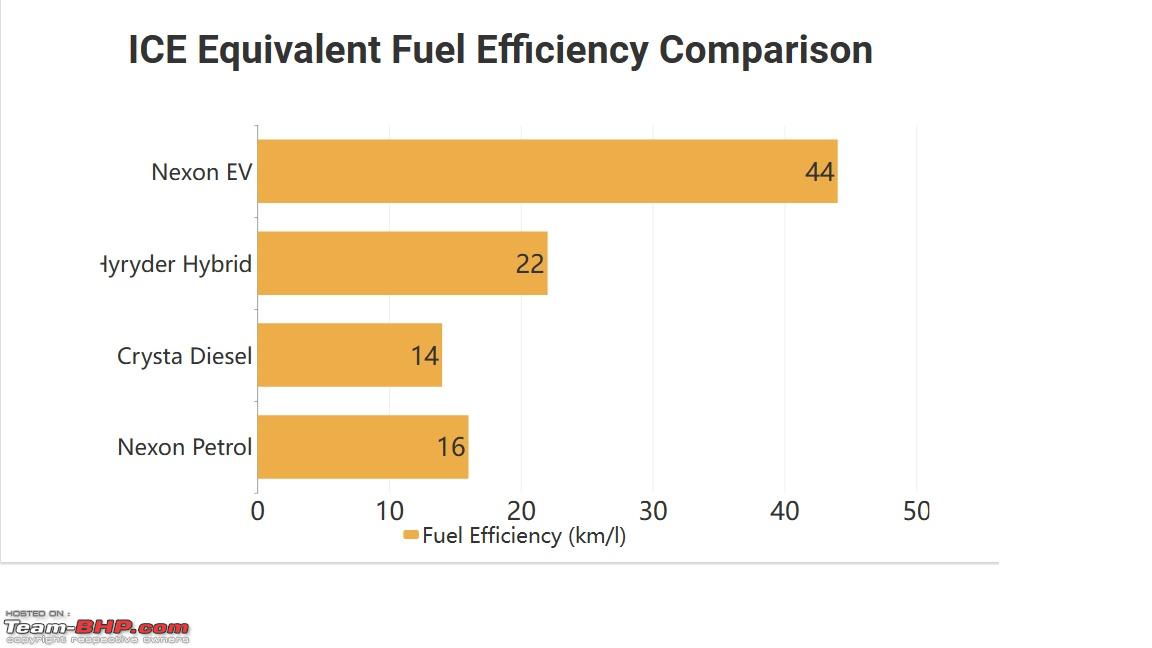
It's just a question of whether you are okay with the risk appetite.
Now before anyone comments about battery degradation, let me lay it out first. Battery degradation in Tata EVs is really low. I have seen many Nexon EVs which have 90% or more battery health after running for 1lakh km.
The battery health of my car is 97%, it ran 38000km to date.Tata service center laptops will show this information, however since it's not user accessible they have full right to deny your request to see the battery health.
Fast charging Etiquette
This is something all EV users should learn. Get into your mind that public charging infrastructure is for everyone, don't hog up chargers unnecessarily.
The problem is most cars charge after 85% and by 95% it's just slow charging.
If you do this 90 to 100% at a public fast charger while others are waiting, you're wasting more than half an hour of the other person's time.
The literal concept of DC fast chargers is to enable interdistrict highway long trips on EVs.
So please don't go to a charging station nearby simply because it's fast. At least have the minimum manners to unplug when someone from far away who actually needs it is waiting in line at the charging station.
I've noticed this unethical behavior the most in Kerala, the place where EV adoption is very high when compared to other states.
What is happening is that many people in Kerala are buying an EV purely because of low running cost and without understanding a thing about how it works or how to charge it properly
Once I was on a long trip and I arrived at a charging station in Kannur. The vehicle there had Kannur RTO plates. I curiously asked him if he was from this place and why he was using the fast charger. To my shock, he replied his home is just a few kilometers away and he regularly charges from here as it's very fast.
EV manufacturers should train their sales team to make EV users aware of this charging etiquette. Also charging companies should work out a system where EV users are incentivized to stop charging before 85%. Autocut off at 85%.
Higher tariffs when charging above 85% are a few measures charging companies can adopt. If the charging infrastructure doesn't grow steadily or if EV users don't learn this fast charging etiquette, EV fast charging can result in a nightmare of having to wait in a queue for hours. Also, there is a problem in govt operated charging stations in Kerala where more than 70% of the chargers are outdated and noncompatible chargers with modern cars. Go figure out how that happened!
Conclusion
So, to conclude are EVs the future? Of course yes.
Can the EVfication get messed up if not done right? Yes, that's a probability too.
So it's the collective job of the EV industry, government, and the mass public to make it work in a proper way. Cheers to more electric miles.
Read BHPian comments for more insights and information.
















